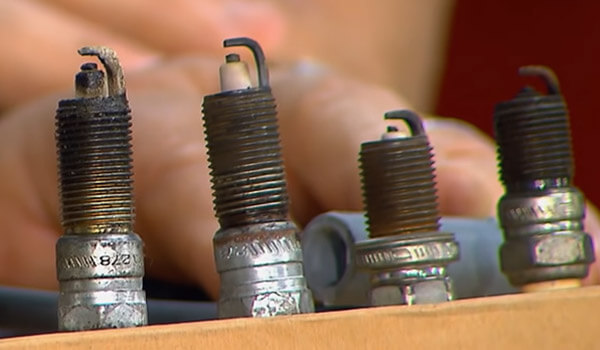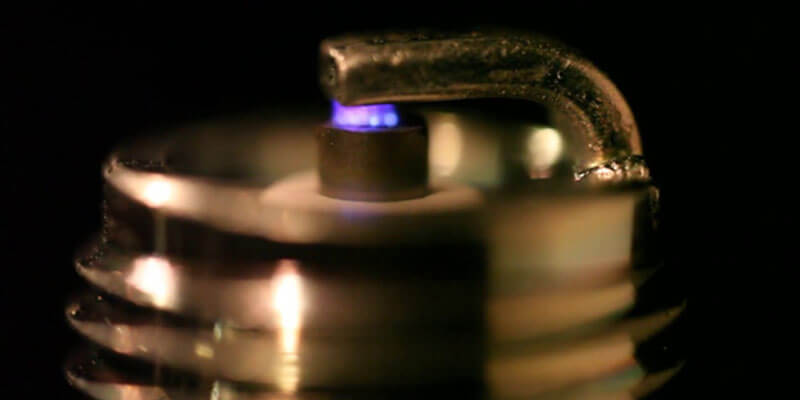In any engine, the spark plug is an essential component. It is responsible for igniting the fuel-air mixture, which powers the motor. If there is no spark to the spark plug, the engine will not run. But what causes no spark to the spark plug?
There are several possible causes of this problem, and we will discuss them in this blog post. We will also provide solutions so that you can get your engine up and running again!
10 Reasons That Causes no Spark to the Spark Plug
If your spark plugs aren’t firing, it could be for several reasons. Here are ten potential causes:

- Dirty or fouled spark plugs are the most common reason for no spark. Over time, deposits from fuel and oil can build up on the electrode, preventing a spark from forming.
- Worn-out spark plugs: As spark plugs age, they can become worn out and no longer able to create a spark, especially in older vehicles with high mileage.
- Lousy ignition coil: The ignition coil is responsible for providing power to the spark plugs. If it’s not working correctly, the plugs won’t get the power they need to create a spark.
- Bad distributor cap: The distributor cap is what distributes the spark to the individual plugs. If it’s damaged or corroded, the spark can’t get where it needs to go.
- Bad rotor: The rotor is responsible for spinning the distributor cap. If it’s damaged, the distributor cap won’t spin, and the spark won’t be distributed.
- Loose wires: Wires can become loose over time, causing a loss of connection between the ignition system and the spark plugs. This can prevent a spark from forming.
- Failed crankshaft position sensor: The crankshaft position sensor tells the ignition system when to fire the spark plugs. If it fails, the system won’t know when to fire them, and no spark will be produced.
- Bad ECU: The ECU is the computer that controls the ignition system. It can prevent the spark plugs from firing if it’s not working correctly.
- Improper gap: The spark plug must be correctly gapped for the engine to function properly. If the gap is too wide, the spark will not be strong enough to ignite the air/fuel mixture. If the gap is too narrow, the spark will be too hot and damage the engine.
- Wrong heat range: If you use a spark plug with the wrong heat range for your engine, it can cause pre-ignition and detonation. This can damage your engine and lead to decreased performance.
These are just a few potential causes for no spark at the spark plugs. If you’re having this problem, it must be diagnosed and repaired as soon as possible to avoid further engine damage.
Tips to Prevent Failed Sparks of Spark Plug
If your spark plugs are not firing correctly, it can cause all sorts of problems for your car. Here are a few tips to help prevent failed sparks of your spark plug.

- First, ensure you’re using your car’s correct type of spark plug. There are many different types of spark plugs on the market, and each type is designed for a specific type of engine. If you’re unsure which type of spark plug to use, consult your car’s owner’s manual or ask a professional mechanic.
- Second, check the gap on your spark plugs regularly. The gap is the distance between the electrode and the tip of the spark plug, and it needs to be set correctly for the spark plug to work properly. Moreover, you can use a feeler gauge to check the gap and adjust it if necessary.
- Third, ensure that your spark plugs are clean and debris-free. Over time, deposits can build up on the spark plugs, preventing them from firing correctly. Finally, you can clean your spark plugs with a wire brush or by soaking them in a cleaning solution.
- Fourth, replace your spark plugs as needed. Even if they’re not visibly dirty or damaged, they will wear out and need to be replaced over time. Consult your car’s owner’s manual for how often to replace your spark plugs.
By following these tips, you can help prevent failed sparks of your spark plug and keep your car running smoothly.
FAQ
The answer is yes; bad ground can cause no spark. If the ground connection between the engine and frame is poor, the engine may not run. The symptoms of bad ground are usually intermittent and may come and go as the connection deteriorates. Sometimes, the bad ground can be challenging to diagnose because the problem may only occur under certain conditions. For example, if you suspect bad ground, have the vehicle checked by a qualified technician.
It’s possible that bad timing is why you do not see any sparks. If the timing is off, it can cause the spark plugs to misfire. This can happen if the spark plugs are old or worn out. It can also occur if there’s something wrong with the ignition system. If you suspect that the timing is off, you should take your car to a mechanic to have it checked out.
One spark plug, not firing can cause several problems. The engine may run erratically, or it may not start at all. If the problem is severe, it can damage the engine.
A bad connection is the most common cause of a spark plug not firing. The spark plug may be loose, or the wire may be damaged. If the problem is a loose connection, it can be fixed by tightening the spark plug. If the problem is a damaged wire, it must be replaced.
Another possible cause of a one spark plug not firing is a build-up of deposits on the spark plug. This can happen if the engine runs on dirty or low-quality fuel. The deposits can be removed by cleaning the spark plug with a wire brush.
Conclusion
Now you know what causes no spark to the spark plug. We hope this article has given you some direction and solutions to the problem of no spark plugs.
If you are still experiencing issues with your car after trying these solutions, don’t hesitate to reach out for help.
Many qualified mechanics would be happy to assist you in finding and fixing the source of your car’s electrical issues.


Hi, on a Toyota 5A engine distributor they is only one cable with power on the two pin socket, does any of cable on the four pin socket suppose to generate power when the ignition is on
Hi Mr Hicks, its been a pleasure reading all your tips on how to keep a car in good running condition. Therefore I would like to ask you something about my ford focus 2013 1.6 petrol. I recently having issue about misfiring after having a timing belt change. At first the mechanic didn’t timed the car properly and it was very sluggish and bad on petrol. Seek some help from another mechanic and the latter did timed the car to its original timing point. Now the issue started that the car start misfire. One of the spark plugs was full with engine oil. I changed all the plugs including the ignition coil pack and the ignition leads. The car still not driving like it should do. Yesterday I cleaned up the throttle with the appropriate spray and also when checking on the plugs I’ve notice that all the plugs are not burning properly. And still the car is running very rich on gas. I would really appreciate if you can help me out please.
Hearing from you would be an immense pleasure.
Regards
Mr S. Dowlut
HI all.. I have a 351 Windsor. it is in a 1933 ford . it was running.. good.. they out of the blue it would not start. so changed the coil.. then the I C M . then the cap and rotor I have spark at the coils but not getting through the distributor . all wires are good and tight I Omed all of them to make sure no cracks or broken wires.. even replace the spark plug wires.. still will not start.. any suggestions. besides a gal of gas and a match
I understand your frustration with the starting issue on your 1933 Ford with a 351 Windsor engine. Let’s go through some additional troubleshooting steps to help you identify the problem:
Check the Distributor Rotor and Cap:
Since you mentioned that you have spark at the coils but it’s not getting through the distributor, start by inspecting the distributor cap and rotor. Ensure they are in good condition, with no cracks, carbon buildup, or corrosion. Replace them if needed.
Check Timing:
Incorrect ignition timing can lead to a no-start condition. Verify that the distributor is properly timed. Ensure the distributor rotor is pointing to the #1 cylinder’s spark plug wire when the engine is at top dead center (TDC) on the compression stroke.
Verify Fuel Supply:
Even if you have spark, you should also check the fuel system. Ensure that fuel is reaching the carburetor or fuel injectors. Check the fuel pump, fuel filter, and fuel lines for any blockages or issues. Try spraying a small amount of starting fluid into the intake to see if the engine attempts to start. If it does, it’s a sign of a fuel delivery problem.
Compression Test:
Perform a compression test on all cylinders to ensure there are no major issues with the engine’s internal components. Low compression in one or more cylinders could prevent the engine from starting.
Inspect the Ignition Control Module (ICM):
Even though you mentioned replacing the ICM, double-check its connections and ensure it’s properly grounded. Faulty or poorly grounded ICMs can cause ignition issues.
Check for Vacuum Leaks:
Inspect all vacuum hoses and connections for leaks. Vacuum leaks can affect engine performance and could be a factor in the no-start condition.
Examine the Distributor Shaft:
Sometimes, the distributor shaft can wear out or become damaged, leading to erratic spark distribution. Ensure the distributor shaft is in good condition and rotates freely.
Ignition Coil Connections:
Confirm that the ignition coil is properly connected and grounded. Loose or damaged connections can lead to weak spark output.
Test for Spark at the Spark Plugs:
Use a spark tester or a spare spark plug to verify spark at the spark plug wires. If you have spark at the distributor but not at the spark plugs, it could be an issue with the distributor cap, rotor, or spark plug wires.
If you’ve checked all these components and still can’t identify the issue, it may be a good idea to consult with an experienced mechanic or an automotive electrician. They can use specialized diagnostic tools and techniques to pinpoint the exact cause of the no-start condition and provide a more accurate diagnosis and repair solution.
Hi Mr I’m from need help have NISSAN TEANA 230JK. ENGINE=VQ23DE. it mix water in oil . I change head gasket . Than start engine it run but not exleratio. No powe . Than shutdown, cranck but not start. How to do?
It seems like you’ve already taken some steps to address the issue with your Nissan Teana’s engine mixing water in the oil by changing the head gasket. However, you’re now facing new issues of poor acceleration, lack of power, and the engine not starting after the initial start. Here are some steps to troubleshoot the current problems:
Check for Coolant Leaks: Ensure that there are no coolant leaks in the cooling system. Leaks could lead to overheating and poor engine performance.
Re-Check the Head Gasket: It’s possible that the head gasket replacement didn’t resolve the issue entirely, or there may be a problem with the installation. Check for any signs of coolant or oil mixing, and verify that the head gasket was installed correctly.
Compression Test: Perform a compression test on all cylinders. Low compression in one or more cylinders could explain the lack of power and starting issues.
Inspect the Ignition System: Check the ignition system components, such as spark plugs, ignition coils, and ignition timing. A weak spark or incorrect timing can cause poor acceleration and starting problems.
Fuel System Inspection: Examine the fuel system, including the fuel filter, fuel pump, and fuel injectors. Ensure that fuel is reaching the engine as it should.
Air Intake and Exhaust: Check for any obstructions or damage in the air intake and exhaust systems. A blocked air filter or exhaust restriction can impact engine performance.
Throttle and Accelerator Pedal: Inspect the throttle body and accelerator pedal for any issues or malfunctions that could affect acceleration.
Timing: Verify that the timing belt or chain is correctly aligned and not damaged. Incorrect timing can lead to engine performance problems.
Sensors and Electronics: Use an OBD-II scanner to check for any fault codes. Faulty sensors or electronic components can cause a lack of power and starting issues.
Coolant System: Make sure the cooling system is functioning properly. Check the thermostat, radiator, and coolant levels to prevent overheating.
Professional Help: If you’re unable to diagnose or fix the problem yourself, it’s advisable to seek assistance from a qualified mechanic. They can use advanced diagnostic tools and their expertise to pinpoint and resolve the issue.
Mixing water in the oil can lead to severe engine damage, so addressing these problems promptly is crucial. Running the engine in this condition can worsen the damage. A professional mechanic will be able to identify and address the root cause of the issues you’re experiencing with your Nissan Teana’s engine.
Morning shameem duwlut
M luking for spark but i don’t hv at the plug cable, it just switched off self but it was raining, my car honda ballade 1996 model 1.6i machenic told me to buy module and plugs but still doing the same,
I understand your concern, and I’ll do my best to help you troubleshoot the issue with your 1996 Honda Ballade 1.6i. It’s important to address the problem step by step.
Check for Spark:
Since you mentioned you don’t have the plug cable, it’s important to confirm whether you have spark in your ignition system. You can do this by using a spark tester or a spare spark plug. Follow these steps:
Remove one of the spark plugs from the engine.
Reconnect the spark plug wire to it.
Hold the threaded part of the spark plug against a metal surface on the engine (for grounding).
Have someone attempt to start the engine while you observe the spark plug gap.
If you see a spark across the gap while cranking the engine, you have spark. If not, there might be an issue with your ignition system.
Check the Ignition Module:
If you’re not getting spark, it’s possible that the ignition module you purchased is faulty or not installed correctly. Make sure it’s connected properly and that all wiring is in good condition. You may want to consider testing the module or having it tested at an auto parts store.
Check the Distributor Cap and Rotor:
In older Honda models like yours, the distributor cap and rotor can be a common source of ignition problems. Inspect them for wear, cracks, or carbon buildup. Replace them if necessary.
Check for Water Damage:
Since you mentioned it was raining when the car switched off, water could have entered the ignition system. Check the distributor and its components for any signs of moisture or water damage. Dry out any wet components and consider using a moisture-displacing spray to prevent future issues.
Fuel System Check:
If you have confirmed that you have spark and the engine still won’t start, it’s possible there’s an issue with the fuel system. Check the fuel pump, fuel filter, and fuel injectors to ensure they are functioning correctly.
If you continue to experience issues after checking these components, it might be a good idea to have a professional mechanic inspect your car in person. They can perform more advanced diagnostic tests and pinpoint the exact cause of the problem. Electrical issues can sometimes be tricky to diagnose and resolve, so professional assistance may be necessary to get your 1996 Honda Ballade running smoothly again.